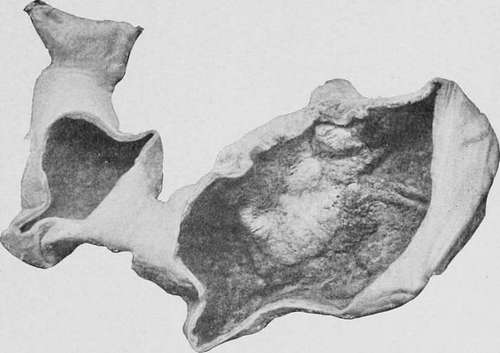Irregular Deformity
Description
This section is from the book "Cancer And Other Tumours Of The Stomach", by Samuel Fenwick. Also available from Amazon: Cancer and other tumours of the stomach.
Irregular Deformity
A growth situated between the orifices may produce considerable alteration in the shape of the stomach. The most frequent deformity from this cause is the partial division of the organ into two sacs (hour-glass contraction). As a rule the disease is of the cylinder-celled variety, and forms a narrow ring round the pyloric segment about three inches from the orifice. As a result of the partial obstruction which is thus produced, the cardiac sac becomes considerably dilated and its muscular coat hypertrophied, while the pyloric portion is either normal in appearance or is more or less invaded by the growth. In other cases a scirrhus of the cardia spreads round the organ at the junction of the fundus with the central portion, and thus divides it into a large thin-walled pyloric sac and a small hypertrophied pouch situated immediately beneath the lower end of the oesophagus. Less frequently the constriction Occurs in the centre of the stomach, and should the amount of infiltration be excessive, the organ may present the appearance of a dumb-bell. This rare condition is well shown in fig. 13, p. 15, where the channel of communication between the cardiac and pyloric pouches measured one inch and a half in length, and barely admitted a small lead pencil.
The other varieties of deformity hardly require a detailed, description. A contracting growth of the lesser curvature tends to approximate the two orifices, with consequent kinking of the duodenum; while an irregular extension of the disease may either divide the viscus into three or four sacs, bend it upon itself, or, by contracting adhesions with the uterus, drag it into a vertical position.

Fig. 23.-Scirrhous carcinoma of the cardiac orifice with hour-glass stomach. (Museum of the Eoyal College of Surgeons.).
Continue to:
- prev: Contraction
- Table of Contents
- next: Ulceration
